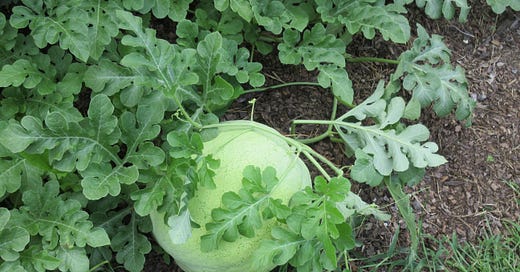ISSUE 42, MELONS, Part 3: Odell's White Watermelon
Odell’s White Watermelon
Though the botanical home of the watermelon is Africa, the varieties of melon sold as seed and at produce stands in the United States were shaped by American seedsmen of the 19th century. Only one commercial variety is known to have been bred by an African-American seedsman—the Odell’s White Watermelon, created by Harry, the foreman of pomologist Willism Summer’s Pomaria plantation in Pomaria, South Carolina in the 1840s. This huge (up to 60 lbs), round, light gray green skinned and pink fleshed melon was famed for its productivity, its delicately sweet pink flesh, and its relative lack of seeds compared to other varieties. In the 1880s horitculturists speculated whether it was an inbred cross of the Imperial Watermelon and the old Carolina Round (now extince). Odell’s white survived in the Dutch Fork region of South Carolina into the 21st century, preserved by the Metze family of Little Mountain SC under the name “Stoney Mountain Watermelon.” It was identified as being the famous Odell’s White by Dr. Jim Kibler of Whitmire, SC.
On September 4, 2018, the Odell’s White was boarded onto the Ark of Taste, Slow Food’s global register of the most historically significant, flavorful, and endangered foods.
One of a group of important melons created in the mid-19th century in the area between Augusta GA and Sumter SC, the Odell’s White gained fame in the region in 1853 when Milton Odell of Mollohon, SC, grew a 53 lb specimen that made the news columns of local papers. His named attached to the variety, and the seeds were distributed nationally in the late 1850s, often under the name “Odell’s Large Round.” When California undertook watermelon farming in the early 1880s in Lodi and Washington, they found the Odell’s the best performing variety. The McGregor Brothers of Washington regularly won the premium for best watermelon at the State Fair during that decade. In the 1890s the water resources and land were redirected to more remunerative crops—fruit farming particularly. The Odell’s White ceased being a major crop melon after its vulnerability to fusarium wilt was discovered in the 1890s.
Seedsman Rodger Winn who now acts as guardian of the Odell’s White Watermelon seed, has distributed the historic melon to Sow True Seed company in Ashville and the Southern Exposure Seed Exchange in Virginia, so home gardeners can grow it out. Besides the crisp, pleasantly sweet flesh, the melon has a ¾ inch white rind ideal for pickling. Last year Rodger Winn posted on FB a picture of his family feasting on the melons that well conveys the pleasure the taste of this melon provides. Here it is . . . a great melon in all its glory being consumed at a farm not five miles from where foreman Harry created it 175 years ago.




